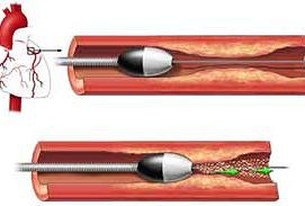Rotational Atherectomy
Rotational atherectomy (RA) is an atheroablative technology that enables percutaneous coronary intervention for complex, calcified coronary lesions. Rotational atherectomy works on the principle of ‘differential cutting’ and preferentially ablates hard, inelastic, calcified plaque. It helps to modify the plaque to enable balloon angioplasty and optimal stent expansion.
The procedure is performed by using a Rotablator catheter, which consists of a spring coil shaft with a burr at the tip. The front edge of the burr is the ablating portion, oval shaped, and covered with fine diamond crystals. The shaft is encased in a plastic sheath and both are connected to an advancer, which has a hand-controlled knob with which the burr can be moved to and fro.
In rotational atherectomy, interventional cardiologists use a revolving diamond burr to break up calcified plaque that is clogging a coronary artery. Breaking up the plaque restores blood flow to the heart and facilitates the passage of the stent to the lesion site where it is implanted.
Our interventional cardiologists are renowned for performing this complex procedure. specifically, at Freeman Hospital Newcastle upon Tyne, United Kingdom.



